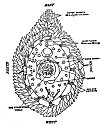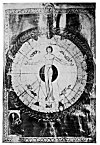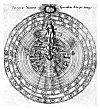Sacred Texts
Earth Mysteries
Index
Previous
Next
St. Hildegard's Universe
THERE IS ANOTHER UNIVERSE of the Middle Ages in which the Earth is like the heart." This is the Universe of Saint Hildegard of Bingen, who lived from 1096 to 1179 or 1180. Saint Hildegard would have been a remarkable woman in any age; in her own she had no parallel.
Abbess of a Benedictine convent near Bingen on the Rhine, she was the first of a great line of women mystics. She founded two convents, was the author of many letters and three books--possibly five--was for those days a physician in her own right, and wrote a long treatise on the nature and properties of herbs. She was interested in statecraft, was a musician and a poet, and over half a hundred hymns are credited to her. Her health was not good, but she governed her convent, wrote her books, healed her sick and ailing, corresponded with the wisest men of her age, and travelled hundreds of miles--in the twelfth century! And with all this, she led the contemplative life.
In that contemplative active life her curious system of the universe blossomed, and in her letters and her books she left the records of her mystical visions of its structure and meaning. These records usually begin with, "The
p. 218
[paragraph continues] Living Light sayeth . . ." It was her name for God, but it was in "The Shade of the Living Light" that she had her perceptions of the universe, and it is interesting to read her simple account of these "Lights." "From my infancy until now in the seventieth year of my age," she says, "my soul has always beheld this light, and in it my soul soars to the summit of the firmament and into different air. . . . The brightness which I see is not limited by space, and is more brilliant than the radiance around the Sun. . . . I cannot measure its height, length, breadth. Its name, which has been given me, is 'Shade of the Living Light.' . . . With that brightness I sometimes see another light for which the name Lux Vivens has been given me. When and how I see this I cannot tell; but sometimes when I see it all sadness and pain is lifted from me, and I seem a simple girl again, and an old woman no more."
In Hildegard's universe, the Earth was the centre, and spherical, around which were arranged concentric shells or zones. The inner zones are spherical, the outer oval or egg-shaped, and the outermost (Fig. 92) so formed as to suggest the acuminated sphere that symbolises the fifth element, quintessence of the other four. This point that tapers into outer space is in the East, which is the top of the diagram. One of her drawings shows, says Singer, that she believed the antipodean surface of the Earth to be uninhabitable, "since it is either beneath the ocean, or in the mouth of the Dragon."
In the interior of the Earth, she believed, are two vast spaces shaped like truncated cones, where punishment was endured, and from whence great evil came forth. The
p. 219

Click to enlarge
FIGURE 92. Hildegard's first scheme of the Universe. Slightly simplified from the Wiesbaden Codex B, folio 14 r.
(From ''The Scientific Views and Visions of Saint Hildegard,'' by Charles Singer; in Studies in the History and Method of Science, ed. by Charles Singer, 1917. Vol. Fig. 2.)
p. 220
[paragraph continues] Earth itself was composed of the four elements, which are represented, curiously unequal in proportion and shape. Their arrangement is not orderly, and this very disorder illustrates one of Hildegard's fundamental doctrines regarding the relation of this world to the universe. Before man's fall, the elements were united in an harmonious combination, and Earth was Paradise; after that catastrophe, the harmony of the universe was disturbed, with the centre of all the trouble on this planet which has ever since remained in its now familiar state of chaotic confusion or mistio, as Hildegard's age called it. This mistio she represents vigorously enough by the irregular distribution of the elements over the Earth. "Thus mingled will they remain until subjected to the melting pot of the Lord Judgment, when they will emerge in a new and eternal harmony, no longer mixed as matter, but separate and pure, parts of a new heaven and a new Earth."
Around this world, says Singer, 1 is spread the atmosphere, the aer lucidus or alba pellis, also circular. Through this alba pellis no Earth creature can penetrate. Later Hildegard seems to have divided this first zone of air into two, the aer tenuis or atmosphere whose outer part is the inner zone of the clouds, and the fortis et albus lucidusque aer, where certain fixed stars are placed.
Beyond this are four outer zones belonging to the four winds, indicated by the breath of supernatural beings.

Click to enlarge
PLATE XXXVII. Nous pervaded by the Godhead embracing the Macrocosm with the Microcosm.
From ''The Scientific Views and Visions of Saint Hildegard,'' by Charles Singer. In Studies in the History and Method of Science, ed. by Charles Singer, 1917, Vol. I, Plate VII.
p. 221
[paragraph continues] They also correspond confusedly to the four elements and to the four regions of the heavenly bodies.
The first is the aer aquosus, corresponding to water, and containing the east wind. In its outer part float clouds, expanding, contracting, and being blown this way and that, thus concealing or revealing the heavenly bodies.
Beyond the aer aquosus, or watery zone, is the purus aether, or zone of air, and containing the west wind. Of all the zones it is the widest, and the long axis of this zone and the remaining outer zones is from east to west, thus fixing the path of movement of the heavenly bodies. It carries in it the constellations of the fixed stars, the Moon, and the two interior planets, Mercury and Venus.
Beyond the zones of east wind and water and of west wind and air is the umbrosa pellis, or ignis niger, the zone of the "dry" and the "earthy," of the north wind, thunder, lightning, and storms. It is a dark, narrow shell which is the storehouse of "the treasures of the snow and of the hail."
The outermost shell is the lucidus ignis, zone of fire, of the south wind, and of the three outer planets, Mars, Jupiter and Saturn--also, in Hildegard's first scheme, of the Sun.
The movements of the four outer zones about each other, which carry the heavenly bodies, are caused by the four winds; and the elements peculiar to each zone are here comparatively pure. Each zone has also its own special mental character, and has a specific influence on the mind and the body of man. For, says Hildegard, "And
p. 222
again I heard the voice from heaven saying, 'God, who created all things, wrought also man in His own image and similitude, and in him He traced (signavit) all created things, and He held him in such love that He destined him for the place from which the fallen angel had been cast."
Plate XXXVII is an illustration from her Liber Divinorum representing her second vision, which shows Nous, the "world-spirit," animated and controlled by the God-head, with arms outstretched embracing the macrocosm with the microcosm. Only the head and the feet of Nous are visible, for the body is covered with the disc of the universe. In this picture of her universe, the zones are seven: they are, from without inwards, says Singer:
a. The lucidus ignis, containing the three outer planets, the sixteen principal fixed stars, and the south wind.
b. The ignis niger, containing the sun, the north wind, and the materials for thunder, lightning, and hail.
c. The purus aether, containing the west wind, the Moon, the two inner planets, and certain fixed stars.
d. The aer aquosus, containing the east wind.
e. The fortis et albus lucidusque aer where certain other fixed stars are placed.
f. The aer tenuis, or atmosphere, in the outer part of which is the zone of the clouds.
From all these zones with all their contents, elements, winds, Sun, Moon, planets, fixed stars, and the great animals or qualities of the heavens, are rained down influences upon the figure of the macrocosm.
Singer quotes a passage from Hildegard's Liber Divinorum
p. 223
to illustrate all this, and most of it can be followed in Plate XXXVII, and in Fig. 92.
"In the middle of the disk [of the universe] there appeared the form of a man, the crown of whose head and the soles of whose feet extended to the fortis et albus lucidusque aer, and his hands were outstretched right and left to the same circle. . . . Towards these parts there was an appearance of four heads, a leopard, a wolf, a lion, and a bear. Above the head of the figure, in the zone of the purus aether, I saw the head of the leopard emitting a blast from its mouth, and on the right side of the mouth the blast, curving itself somewhat backwards, was formed into a crab's head . . . while on the left side of the mouth a blast similarly curved ended in a stag's head. From the mouth of the crab's head, another blast went to the middle of the space between the leopard and the lion, and from the stag's head a similar blast to the middle of the space between the leopard and the bear . . . and all the heads were breathing towards the figure of the man. Under his feet in the aer aquosus there appeared as it were the head of a wolf, sending forth to the right a blast extending to the middle of the half space between its head and that of the bear, where it assumed the form of the stag's head; and from the stag's mouth there came as it were another breath which ended in the middle line. From the left of the wolf's mouth arose a breath which went to the middle of the half space between the wolf and the lion, where was depicted another crab's head . . . from whose mouth another breath ended in the same middle line . . . And the breath of all the heads extended sideways from
p. 224
one to another. . . . Moreover, on the right hand of the figure in the lucidus igni, from the head of the lion, issued a breath which passed laterally on the right into a serpent's head and on the left into a lamb's head . . . similarly on the figure's left in the ignis niger, there issued a breath from the bear's head ending on its right in the head of [another] lamb, and on its left in another serpent's head . . . And above the head of the figure the seven planets were ranged in order, three in the lucidus ignis, one projecting into the ignis niger, and three into the purus aether. . . . And in the circumference of the circle of the lucidus ignis there appeared the sixteen principal stars, four in each quadrant between the heads. . . . Also the purus aether and the fortis et albus lucidusque aer seemed to be full of stars which sent forth their rays towards the clouds, whence . . . tongues like rivers descended to the disk and towards the figure, which was thus surrounded and influenced by these signs."
In Hildegard's fourth vision--of the influence of the heavenly bodies and the pure elements on men, animals, and plants, she saw, from the upper fiery firmament, the lucidus ignis, ashes as it were cast to the Earth, which produced rashes and ulcers in men and animals and fruits. From the ignis niger she saw vapours (nebulæ) descending, which withered the plants and dried up the earth. Against these descending influences the purus aether struggled, seeking to hold back the plagues of disease and drought.
From the fortis et albus lucidusque aer she saw certain clouds descend to the Earth and infect men and beasts

Click to enlarge
PLATE XXXVIII (From Uriusque Cosmi; Robert Fludd, 1621. Vol. I)
p. 225
with a pestilence, but this plague the aer aquosus opposed, so that all were not destroyed. In the aer tenuis she saw its moisture as if it were boiling above the surface of the Earth, rousing the force of the Earth, and compelling it to bring forth its fruits by aid of the cosmic rays.
In the whole of her scheme of the universe, the winds are of prime importance. Were it not for the winds, which, she said, are the wings of God's power, the other three elements, the fires of the south, the waters of the west, and the great shadows of the north would burst over the Earth and destroy it. Or, were the four winds to move forward at once, the elements themselves would be split asunder, and the waters of the sea would be dried up. As man's body, she said, is held together by the soul, so the firmament is held together by the winds, which are, like the soul, invisible.
In developing her theory of the correspondence of the microcosm to the macrocosm, of man to the universe and God, she set down many of its details. The firmament corresponds to the head of man, in which, from the top of the cerebral cavity to "the last extremity of the forehead," are seven marked spaces all equal, which correspond to the seven planets, all of which, says Hildegard, are equally distant from each other in the heavens. The Sun, Moon, and stars she compares to his eyes; air is his hearing, the winds his smelling, the dew of heaven his tasting, and the sides of the world his arms and his touching. The Earth is like the heart of the cosmos, for it, like the heart of man, can be stirred by emotion; and, as the heart of man, moved by joy or sorrow, excites the brain to cause tears to flow,
p. 226
so the Earth, when the Moon begins to wax and wane, sends up her tears, the fogs of her oceans and seas.

Footnotes
220:1 "The Scientific Views and Visions of Saint Hildegard;" Charles Singer: In Studies in the History and Method of Science, Vol. I, 1917, pp. 22-36.
Next: The Earths in the Universe



